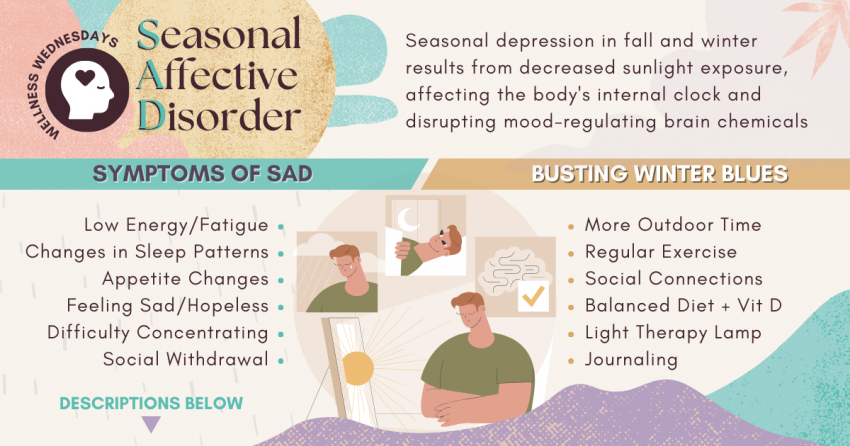Seasonal Affective Disorder (SAD) casts a shadow over well-being during the darker months, causing symptoms like low energy and persistent sadness. To combat SAD, prioritize exposure to natural light, maintain a regular sleep schedule, and consider light therapy. Small lifestyle adjustments can make a significant difference in overcoming the winter blues and fostering mental well-being.
Seasonal Affective Disorder (SAD) is linked to changes in light exposure, particularly during fall and winter which can cause the following symptoms:
- Low Energy/Fatigue: Limited sunlight exposure disrupts the body’s internal clock (circadian rhythm), leading to altered sleep-wake cycles and reduced energy levels
- Changes in Sleep Patterns: Reduced sunlight can impact melatonin and serotonin levels, affecting sleep regulation and leading to insomnia or oversleeping
- Appetite Changes: Light influences the production of serotonin, a neurotransmitter linked to mood and appetite. Reduced sunlight can lead to increased cravings for carbohydrates and comfort foods
- Feeling Sad/Hopeless: Lack of sunlight affects serotonin levels, which play a role in regulating mood. Lower serotonin levels are associated with feelings of sadness and hopelessness
- Difficulty Concentrating: Changes in serotonin levels also impact cognitive function, contributing to difficulties in concentration and memory
- Social Withdrawal: The emotional impact of SAD, coupled with fatigue and mood changes, can lead to a desire to withdraw from social interactions
Factors like genetics, hormonal changes, and individual susceptibility also play a role in its onset. Try these strategies to combat the symptoms of Seasonal Affective Disorder:
- More Outdoor Time: Exposure to natural light, even on cloudy days, can help regulate circadian rhythms and improve mood. You can also maximize exposure to natural light indoors by keeping curtains open and arranging furniture to allow sunlight in
- Regular Exercise: Physical activity has been shown to have positive effects on mood and can help alleviate symptoms of depression, including those associated with SAD
- Social Connections: Maintaining social connections and engaging in activities with others can provide emotional support and reduce feelings of isolation
- Balanced Diet + Vitamin D: A nutritious diet, including foods rich in vitamin D, can contribute to overall well-being. In regions with limited sunlight during the winter, vitamin D supplements may also be beneficial
- Light Therapy Lamp: Light therapy, or phototherapy, involves exposure to a bright light that mimics natural sunlight. This can be especially helpful for individuals affected by the reduced daylight hours in the winter
- Journaling: Keeping a journal can provide an outlet for expressing thoughts and emotions, promoting self-reflection and emotional well-being
- Establish a Routine: Maintain a regular daily routine to provide structure and stability
- Mindfulness and Relaxation Techniques: Practice mindfulness, meditation, or relaxation exercises to reduce stress and improve mood
- Ensure Adequate Sleep: Prioritize good sleep hygiene, aiming for consistent and sufficient sleep each night
- Consider Warm Colors: Use warm and bright colors in your living environment to create a more uplifting atmosphere
These strategies address different aspects of SAD, combining lifestyle changes, social support, and targeted therapies like light therapy. It’s important for individuals with SAD to explore a combination of these approaches to find what works best for them. Additionally, consulting with a healthcare professional can help tailor a treatment plan based on individual needs and circumstances.
This Verilux HappyLight Lucent LED Light Therapy Lamp lives on Ms. Gill’s office desk. In general, most light therapy sessions for SAD involve exposure to a bright light that simulates natural sunlight. The typical recommendation is to start with about 20-30 minutes of exposure per day, usually in the morning. The light intensity of the lamp is an important factor, and it’s often recommended to use a lamp with an intensity of 10,000 lux.
It’s important to note that individual responses to light therapy can vary, and some people may benefit from longer or shorter sessions. It’s also crucial to follow the recommendations provided by healthcare professionals and the manufacturer of the light therapy lamp. If you’re considering light therapy for SAD, it’s advisable to consult with a healthcare provider to determine the appropriate duration, timing, and intensity of the light exposure for your specific situation. They can provide personalized recommendations based on your symptoms, lifestyle, and overall health. Additionally, it’s important to use a light therapy lamp that meets established safety standards to avoid potential side effects or damage to your eyes.
